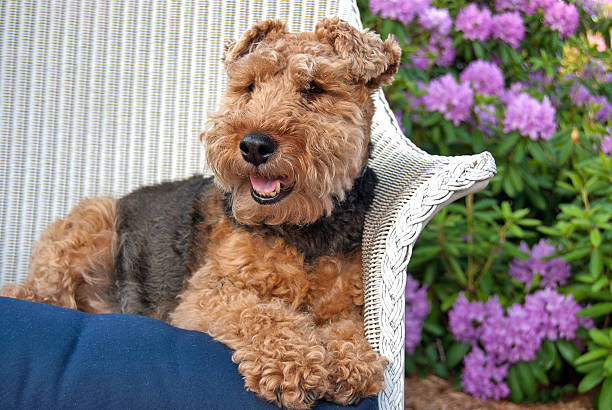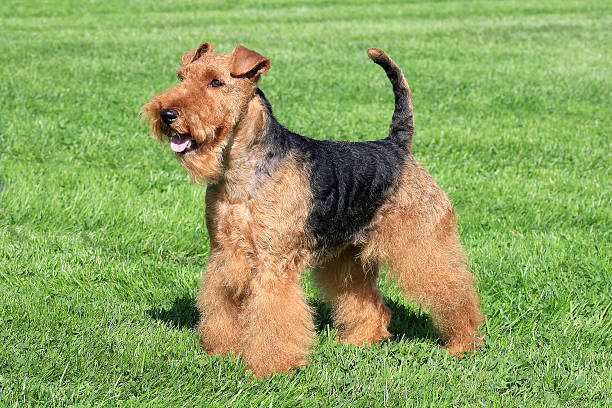Welsh Terrier

Breed History:
The Welsh Terrier hails from Wales, where it was originally bred for hunting foxes, badgers, and other small game. One of the oldest terrier breeds, it is thought to descend from the now-extinct Black and Tan Terrier and has retained much of its original working dog spirit. Compact, sturdy, and spirited, the Welsh Terrier is known for its friendly yet feisty personality.
Historically favoured by farmers and sportsmen for its courage and tenacity, the breed later gained popularity as a family companion. Its wiry, low-shedding coat is relatively easy to maintain and well-suited to active households, making it both practical and charming.
Height: 40 cm
Weight: 9-9.5 kg
Size – Small
Life Expectancy: 12 years

Breed Appearance:
The Welsh Terrier is a medium-small breed known for its wiry, dense coat and confident, spirited personality. Its black and tan fur lies close to the body and requires regular hand-stripping or grooming to maintain its texture and keep it tidy. Unlike softer-coated breeds, the Welsh Terrier’s rugged coat is designed for protection during outdoor activity, reflecting its origins as a working dog.
With a rectangular head, expressive dark eyes, and a tail typically carried high, the Welsh Terrier has a bold, alert presence. Its sturdy, compact frame and energetic gait showcase its athleticism and lively temperament.
Breed Type - Family/guard:
The Welsh Terrier is an energetic, affectionate breed known for its confidence and spirited nature. Loyal to its family, it enjoys companionship and thrives in active households where it can be part of everyday activities. While it can be independent and strong-willed, the Welsh Terrier forms close bonds with its owners and is eager to please. Naturally friendly, it generally gets along well with people, though its alertness and bold temperament make it a capable watchdog. Early socialisation helps channel its lively personality into positive behaviour.

Training:
Quick learners, Welsh Terriers are intelligent and eager, though their independent streak can present training challenges. They respond best to firm, consistent training that includes positive reinforcement and clear boundaries. Because of their strong prey drive and natural curiosity, early socialisation and obedience work are essential. While they enjoy mental stimulation and engaging tasks, patience and persistence are key to shaping their focus and harnessing their lively spirit effectively.
Health & Care:
The Welsh Terrier is generally a hardy and healthy breed, with a typical lifespan of around 12 to 15 years when well cared for. Though relatively robust, they may be prone to certain conditions such as hypothyroidism, lens luxation, and allergies. Routine veterinary care and early screening help in managing these potential issues effectively.
Their wiry coat requires regular brushing and periodic hand-stripping to keep it in good condition and to prevent skin problems. As active dogs, they need a balanced diet and regular exercise to maintain a healthy weight. Good dental hygiene is also important to avoid plaque buildup and oral health issues.

Living Conditions:
Originally bred for hunting and farm work, the Welsh Terrier is best suited to homes that can match its energy and provide plenty of mental and physical stimulation. While adaptable to urban living, including apartments, they thrive in environments where they have space to explore and opportunities for regular exercise. They are happiest with active families who can include them in daily routines and outdoor adventures.
Welsh Terriers need consistent activity, such as brisk walks, playtime, or training sessions, to stay mentally and physically fit. They enjoy engaging tasks and benefit from interactive toys or games. Their wiry coat requires regular grooming, and they should be supervised in unsecured areas due to their strong prey drive and curious nature.
Exercise:
Like all dogs, the Welsh Terrier requires regular exercise to stay healthy, both physically and mentally. With its high energy levels and playful nature, this breed thrives on daily activities that include brisk walks, active play sessions, and structured training exercises. Welsh Terriers enjoy games like fetch, tug-of-war, and agility challenges, which tap into their natural drive and curiosity.
They are intelligent and benefit from mentally stimulating tasks such as scent games, puzzle toys, or advanced obedience training. Their exercise routine should be varied and consistent to prevent boredom, which can lead to destructive behaviour. Providing a mix of physical exertion and mental enrichment ensures a well-balanced, contented Welsh Terrier.
Grooming:
The Welsh Terrier’s wiry coat requires regular grooming to keep it healthy and looking its best. Weekly brushing is recommended to prevent mats and tangles, especially around the ears, neck, and underbelly. Hand-stripping is typically necessary to maintain the coat’s texture and remove dead hair, though some owners may opt for professional grooming. While the breed sheds minimally, regular maintenance is essential to keep the coat in optimal condition. Routine grooming not only helps maintain their appearance but also promotes healthy skin and fur.

Advantages:
-
Distinctive, wiry coat and bold expression give it a unique, charming appearance
-
Loyal, affectionate, and forms strong bonds with its family
-
Energetic and playful, great for active families
-
Good with children and other pets when socialised early
-
Adaptable to apartment living, provided it gets enough exercise
-
Intelligent and trainable, with a desire to please
-
Excellent watchdog despite its small size, alert without being overly aggressive
Disadvantages:
-
Requires regular grooming and hand-stripping to maintain its coat
-
Independent nature can make training challenging at times
-
Prone to health issues like hypothyroidism, allergies, and lens luxation
-
Needs consistent mental and physical stimulation—can become bored or destructive if under-stimulated
-
Strong prey drive and curiosity may lead to wandering if not supervised
-
Sensitive to cold weather and may need protection in colder climates
-
Can be prone to separation anxiety if left alone for extended periods

